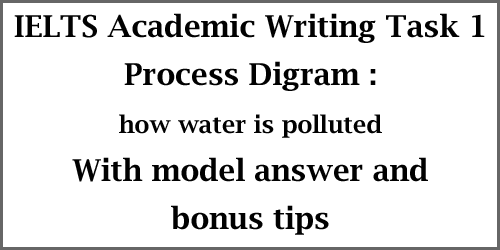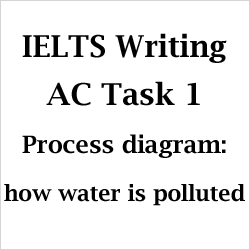In this IELTS Academic Writing Task 1 post, we are going to look at a process diagram. This diagram presents an illustration of how surface and underground water are polluted. The post will help you write any process diagram easily as well as get some bonus tips.

Types:
Usually, there are two different types of process question: natural or environmental and man-made or manufacturing.
Natural processes are commonly cycled diagrams but they can also show how a singular system works.
A man-made or manufacturing process means the diagram that shows how a product is made. It can also depict different kinds of pollutions that are happening right now around the world.
To write a solid and pitch-perfect answer to this sort of questions, candidates need the same skills and system to answer process questions which they have learned when answering cycle diagram.
Plan your writing:
Try to follow the given instructions and tips below to answer a process diagram:
- Try to understand the whole process. It may be difficult for many of the candidates to comprehend a process at the beginning but practicing them regularly will surely give good outcomes. Locate the opening and the culmination of the process. Calculate the number of stages and know what every stage does and the connection of the stage with the stages before and after it.
- You must paraphrase the question title. You cannot copy the question directly.
- Give an overview of the picture provided. Learn how to write an overview here.
- Learn how to divide the process. For this process, we are going to divide it into two independent segments.
- When the writing is done, check it thoroughly to find out the mistakes.
Let’s have a look at this process diagram.
The diagram shows how water becomes polluted in urban and rural areas.
Let’s ask some questions to have a clear understanding of the picture:
- What is this picture about?
- Is it a natural process, a cycle or a production or manufacturing process?
- Where does it start and where does it end?
- How many stages are there? (Remember that sometimes the number of stages are not included)
- Do we need to include any information that is not available in the picture?
- Is any stage connected to any other stage?
If we can answer these questions well, our writing will become easier.
Let’s answer the questions by looking at the given picture here.
Answers:
- The picture is about contamination of water both in surface and underground level in cities and villages.
- It is a combination of man-made and natural processes.
- Actually, the picture suggests that it doesn’t have a start or end. But it is interesting to see that the process happens in four places.
- For this picture, it is quite difficult to count the number of stages because it is happening in four places separately but somehow they are connected.
- It is not needed but we may include some information that is directly connected to the picture.
- Yes, some stages are connected; like the toxic fumes created in the industrial area is connected to acid rain which pollutes the river water.
So, you can see that asking questions helps a lot to understand the picture. Try to collect some Task 1 pictures and practice asking the questions with your classmates or friends. Write the answers on a notebook. Then match the answers with other pictures. You will locate some differences.
Now comes the writing part. It is important to learn Present Indefinite Tense or Simple Present Tense to answer this question. You should also learn Active and Passive voice structures.
Here is a model answer for you that I’ve prepared. Remember, this is only one answer out of many possible approaches. Your answers may vary with this but that does not necessarily mean that your one is not correct. So, you should show your answer to an IELTS trainer or expert.
Model answer:
The depicted diagram is a clear presentation of water contamination both in cities and the countryside. Overall, it is clearly seen that the pollution of water occurs in four locations and they are interlaced to some extent.
When looking closely at the diagram, toxic fumes are created in industrial areas from different mills and factories which blend with clouds. Thus clouds have more sulfur and nitrogen concentration which results in highly toxic acid rain. Rainwater contaminates freshwater sources like lakes and rivers and washes off pollutants from hilly areas and urban zones to low-lying regions. In urban areas, water is also polluted by the release of oils and grease from automobiles, hazardous waste composites, and leakage of gas and oil in underground storage tanks. All these pollutants infiltrate the earth and reach the underground water level. City landfill is another place of a high level of water contamination.
In rural areas, animal wastes and septic tank wastes are released on the surface and the underground level. Crop seeder planes discharge fertilizers and pesticides on the farmlands. Last but not least, boats and floating devices discharge lubricants such as mobil and oils on the river water, and water treatment plants even get polluted.
Thus, water in both upper and lower levels gets adulterated.
(212 words)
Here are some bonus tips for writing answers to a diagram:
- Use connectors where necessary but do not overdo it.
- When you feel to add any information or words which is not present in the picture, be sure it directly indicates the point where it is used.
Never add any personal opinions or reasons or effects. You are to write on the information you see. That’s all.
Here are some other diagrams that you can practice:
Flow-chart on sweater manufacturing
Process diagram on olive oil production
Two maps showing changes in an industrial village
Two maps showing changes in a town
Life cycle diagram on tuna fish
Life cycle diagram on silkworm moth
Cycle diagram on water movement

